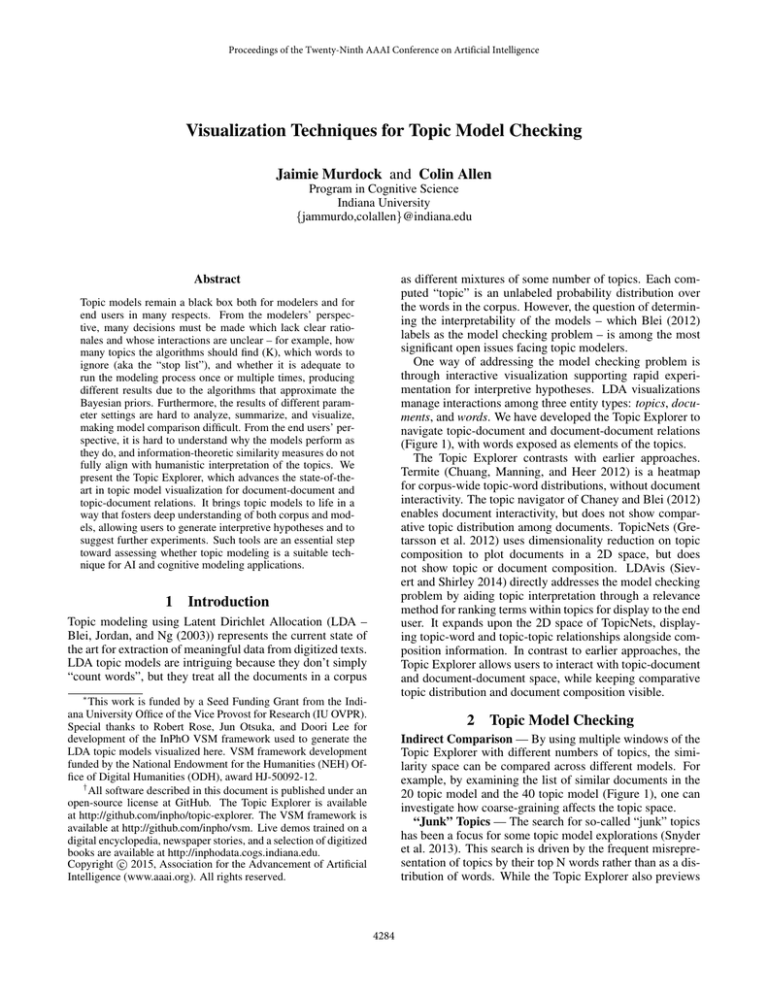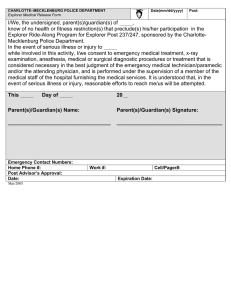
Proceedings of the Twenty-Ninth AAAI Conference on Artificial Intelligence
Visualization Techniques for Topic Model Checking
Jaimie Murdock and Colin Allen
Program in Cognitive Science
Indiana University
{jammurdo,colallen}@indiana.edu
Abstract
as different mixtures of some number of topics. Each computed “topic” is an unlabeled probability distribution over
the words in the corpus. However, the question of determining the interpretability of the models – which Blei (2012)
labels as the model checking problem – is among the most
significant open issues facing topic modelers.
One way of addressing the model checking problem is
through interactive visualization supporting rapid experimentation for interpretive hypotheses. LDA visualizations
manage interactions among three entity types: topics, documents, and words. We have developed the Topic Explorer to
navigate topic-document and document-document relations
(Figure 1), with words exposed as elements of the topics.
The Topic Explorer contrasts with earlier approaches.
Termite (Chuang, Manning, and Heer 2012) is a heatmap
for corpus-wide topic-word distributions, without document
interactivity. The topic navigator of Chaney and Blei (2012)
enables document interactivity, but does not show comparative topic distribution among documents. TopicNets (Gretarsson et al. 2012) uses dimensionality reduction on topic
composition to plot documents in a 2D space, but does
not show topic or document composition. LDAvis (Sievert and Shirley 2014) directly addresses the model checking
problem by aiding topic interpretation through a relevance
method for ranking terms within topics for display to the end
user. It expands upon the 2D space of TopicNets, displaying topic-word and topic-topic relationships alongside composition information. In contrast to earlier approaches, the
Topic Explorer allows users to interact with topic-document
and document-document space, while keeping comparative
topic distribution and document composition visible.
Topic models remain a black box both for modelers and for
end users in many respects. From the modelers’ perspective, many decisions must be made which lack clear rationales and whose interactions are unclear – for example, how
many topics the algorithms should find (K), which words to
ignore (aka the “stop list”), and whether it is adequate to
run the modeling process once or multiple times, producing
different results due to the algorithms that approximate the
Bayesian priors. Furthermore, the results of different parameter settings are hard to analyze, summarize, and visualize,
making model comparison difficult. From the end users’ perspective, it is hard to understand why the models perform as
they do, and information-theoretic similarity measures do not
fully align with humanistic interpretation of the topics. We
present the Topic Explorer, which advances the state-of-theart in topic model visualization for document-document and
topic-document relations. It brings topic models to life in a
way that fosters deep understanding of both corpus and models, allowing users to generate interpretive hypotheses and to
suggest further experiments. Such tools are an essential step
toward assessing whether topic modeling is a suitable technique for AI and cognitive modeling applications.
1
Introduction
Topic modeling using Latent Dirichlet Allocation (LDA –
Blei, Jordan, and Ng (2003)) represents the current state of
the art for extraction of meaningful data from digitized texts.
LDA topic models are intriguing because they don’t simply
“count words”, but they treat all the documents in a corpus
∗
This work is funded by a Seed Funding Grant from the Indiana University Office of the Vice Provost for Research (IU OVPR).
Special thanks to Robert Rose, Jun Otsuka, and Doori Lee for
development of the InPhO VSM framework used to generate the
LDA topic models visualized here. VSM framework development
funded by the National Endowment for the Humanities (NEH) Office of Digital Humanities (ODH), award HJ-50092-12.
†
All software described in this document is published under an
open-source license at GitHub. The Topic Explorer is available
at http://github.com/inpho/topic-explorer. The VSM framework is
available at http://github.com/inpho/vsm. Live demos trained on a
digital encyclopedia, newspaper stories, and a selection of digitized
books are available at http://inphodata.cogs.indiana.edu.
c 2015, Association for the Advancement of Artificial
Copyright Intelligence (www.aaai.org). All rights reserved.
2
Topic Model Checking
Indirect Comparison — By using multiple windows of the
Topic Explorer with different numbers of topics, the similarity space can be compared across different models. For
example, by examining the list of similar documents in the
20 topic model and the 40 topic model (Figure 1), one can
investigate how coarse-graining affects the topic space.
“Junk” Topics — The search for so-called “junk” topics
has been a focus for some topic model explorations (Snyder
et al. 2013). This search is driven by the frequent misrepresentation of topics by their top N words rather than as a distribution of words. While the Topic Explorer also previews
4284
Figure 1: Screenshot of the Topic Explorer showing a 20-topic model (left) and a 40-topic model (right) centered on the Stanford
Encyclopedia of Philosophy (SEP) article on Turing Machines. The color bands within each article’s row show the topic
distribution within that article, and the size of each band indicates the weight of that topic in the article. The combined width
of each row indicates the similarity to the focal topic or document, measured by the quantity SIM(doc) = 1 − JSD(doc, f ocal),
where JSD is the Jensen-Shannon distance (Lin 1991) between the word probability distributions of each item. Hovering over
a topic shows the top 10 words in that topic and highlights the distribution of that topic across selected documents. By clicking
a topic, the documents will reorder according to that topic’s weight and topic bars will reorder according to the topic weights
in the highest weighted document. When a topic is selected, clicking “Top Documents for [Topic]” will navigate to a new page
showing the most similar documents to that topic’s word distribution. By normalizing topics, the combined width of each bar
expands so that topic weights per document can be compared. Additionally, users may select among different topic models
using different values for K, the number of topics. Each topic’s label and color are arbitrarily assigned, but are consistent across
articles in the browser for each topic model.
the top N words, it can suggest hypotheses about the deeper
structure of the topic through the topic-document similarity
view. For instance, topics that seem initially uninterpretable
are sometimes diagnostic of a sub-genre or style of writing (Hughes et al. 2012); they may also select for specialized sections of the documents, such as bibliographies; or
highlight digitization errors, such as the inclusion of page
numbers or section headings, or common misspellings introduced by optical character recognition (OCR). The Topic
Explorer can make these salient, rendering one person’s
“junk” another person’s treasure.
3
Chaney, A. J.-B., and Blei, D. M. 2012. Visualizing Topic
Models. In International AAAI Conference on Social Media
and Weblogs.
Chuang, J.; Manning, C. D.; and Heer, J. 2012. Termite: Visualization Techniques for Assessing Textual Topic Models.
In Proceedings of the International Working Conference on
Advanced Visual Interfaces, 74–77. ACM.
Gretarsson, B.; Odonovan, J.; Bostandjiev, S.; Höllerer, T.;
Asuncion, A.; Newman, D.; and Smyth, P. 2012. TopicNets:
Visual Analysis of Large Text Corpora with Topic Modeling.
ACM Transactions on Intelligent Systems and Technology
(TIST) 3(2):23.
Hughes, J. M.; Foti, N. J.; Krakauer, D. C.; and Rockmore,
D. N. 2012. Quantitative Patterns of Stylistic Influence in
the Evolution of Literature. Proceedings of the National
Academy of Sciences 109(20):7682–7686.
Lin, J. 1991. Divergence Measures Based on the Shannon Entropy. IEEE Transactions on Information Theory
37(1):145–151.
Sievert, C., and Shirley, K. E. 2014. LDAvis: A Method
for Visualizing and Interpreting Topics. Proceedings of the
Workshop on Interactive Language Learning, Visualization,
and Interfaces 63–70.
Snyder, J.; Knowles, R.; Dredze, M.; Gormley, M.; and
Wolfe, T. 2013. Topic Models and Metadata for Visualizing Text Corpora. In Proceedings of the 2013 NAACL HLT
Demonstration Session, 5–9. Atlanta, Georgia: Association
for Computational Linguistics.
Conclusion
In this paper, we described the Topic Explorer, a new visualization that exposes the topic-document and documentdocument space of LDA topic models. It addresses the
model checking problem – that is, the humanistic interpretation of topics – rather than formal topic model evaluation.
Given that multiple models yield different but interpretable
results, future attempts to exploit LDA for AI or cognitive
modeling purposes would be well advised to consider simultaneously modeling multiple levels of K.
References
Blei, D. M.; Ng, A. Y.; and Jordan, M. I. 2003. Latent
Dirichlet Allocation. Journal of Machine Learning Research
3:993–1022.
Blei, D. M. 2012. Probabilistic Topic Models. Communications of the ACM 55(4):77–84.
4285




